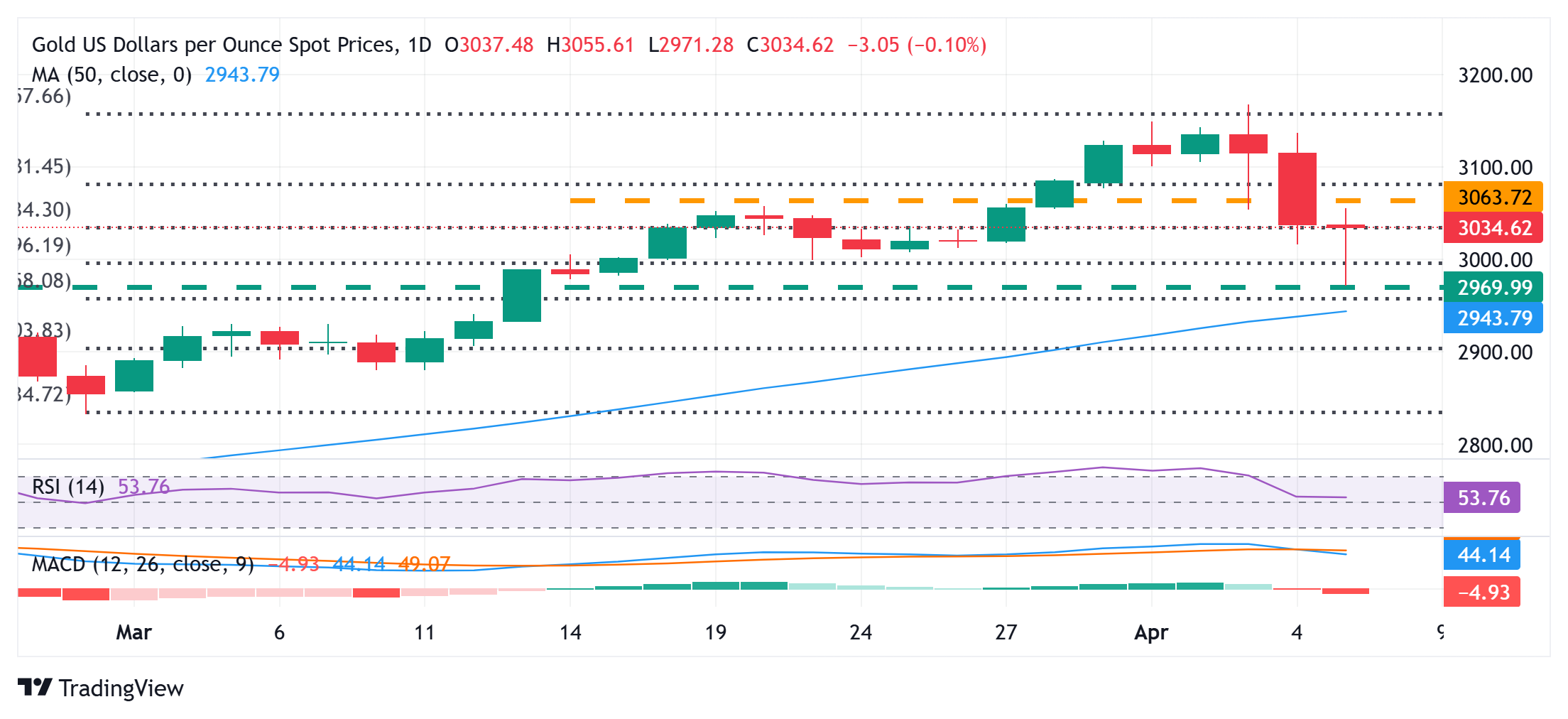- Gold price reverses an Asian session slide to over a three-week low, though it lacks follow-through.
- Recession fears continue to weigh on investor sentiment and benefit the safe-haven commodity.
- Bets for more aggressive Fed rate cuts undermine USD and also lend support to the XAU/USD pair.
Gold price (XAU/USD) attracts some sellers near the $3,055 support-turned-resistance and stalls its intraday recovery from the $2,972-2,971 area, or a nearly four-week low touched earlier this Monday. Investors continue to unwind their bullish positions to cover losses from a broader meltdown across the global financial markets, which acts as a headwind for the precious metal. That said, an extended sell-off in the equity markets, triggered by US President Donald Trump’s sweeping reciprocal tariffs announced last week, offers some support to the safe-haven commodity.
Meanwhile, data published earlier today showed that the People’s Bank of China (PBOC) increased its state Gold reserves for the fifth straight month. Adding to this, the emergence of fresh US Dollar (USD) selling, triggered by bets that a tariffs-driven US economic slowdown might force the Federal Reserve (Fed) to resume its rate-cutting cycle soon, lends additional support to the non-yielding Gold price. This, along with persistent geopolitical risks, warrants caution before positioning for an extension of the XAU/USD pair’s pullback from the all-time top touched last week.
Daily Digest Market Movers: Gold price draw support from the global flight to safety; bulls lack conviction
- The widening global trade war continues to fuel concerns about a global economic recession and leads to an extended sell-off in equity markets across the world. This, in turn, prompted traders to liquidate their long positions around the Gold price and raise cash to cover losses elsewhere.
- According to data released this Monday, the People’s Bank of China (PBOC) added gold to its reserves for a fifth consecutive month in March. In fact, the People’s Bank of China’s holding rose by 0.09 million troy ounces last month amid rising global trade and geopolitical turmoil.
- US President Donald Trump imposed reciprocal tariffs of at least 10% on all imported goods late last Wednesday, with China facing 54% levies under this new regime. In response, China’s Commerce Ministry announced on Friday that they will levy additional tariffs of 34% on all US imports.
- Meanwhile, US Commerce Secretary Howard Lutnick confirmed on Sunday that the tariffs would not be postponed and the policy would remain in place for days and weeks. Adding to this, Trump stated that there would be no deal with China unless the trade deficit is solved.
- The US Dollar struggles to capitalize on Friday’s modest recovery move from a multi-month low that followed the release of the better-than-expected US Nonfarm Payrolls (NFP) report. In fact, the closely-watched jobs data showed that the economy added 228K jobs in March vs. 117K previous.
- Meanwhile, Federal Reserve (Fed) Chair Jerome Powell said that that inflation is closer to target but still slightly elevated. Powell added that Trump’s tariffs could have a strong inflationary impact and that the Fed’s job is to avoid temporary price hikes turning into persistent inflation.
- Investors, however, are still pricing in the possibility that the US central bank will resume its rate-cutting cycle in June and also lower borrowing costs at least four times this year. This, along with the anti-risk low, keeps the yield on the benchmark 10-year US government bond below the 4.0% mark.
- This, in turn, holds back the USD bulls from placing aggressive bets and assists the non-yielding yellow metal to stage a modest intraday bounce from a nearly four-week low touched during the Asian session on Monday. The lack of follow-through, however, warrants caution for bulls.
Gold price needs to surpass $3,055 support-turned resistance for bulls to regain short-term control

From a technical perspective, last week’s sharp retracement slide from the all-time peak stalls ahead of the 61.8% Fibonacci retracement level of the February-April strong move up. The subsequent move up, however, falters near the $3,055 horizontal support breakpoint, now turned resistance. The latter should now act as a key pivotal point for intraday traders, above which the Gold price could climb to the $3,080 region en route to the $3,100 round figure.
On the flip side, the $3,000 psychological mark, which coincides with the 50% retracement level, now seems to protect the immediate downside ahead of the $2,972-2,971 area, or the multi-week low touched earlier this Monday. This is closely followed by the 50-day Simple Moving Average (SMA), around the $2,946 area, which if broken decisively might shift the near-term bias in favor of bearish traders and pave the way for a further depreciating move.
Fed FAQs
Monetary policy in the US is shaped by the Federal Reserve (Fed). The Fed has two mandates: to achieve price stability and foster full employment. Its primary tool to achieve these goals is by adjusting interest rates.
When prices are rising too quickly and inflation is above the Fed’s 2% target, it raises interest rates, increasing borrowing costs throughout the economy. This results in a stronger US Dollar (USD) as it makes the US a more attractive place for international investors to park their money.
When inflation falls below 2% or the Unemployment Rate is too high, the Fed may lower interest rates to encourage borrowing, which weighs on the Greenback.
The Federal Reserve (Fed) holds eight policy meetings a year, where the Federal Open Market Committee (FOMC) assesses economic conditions and makes monetary policy decisions.
The FOMC is attended by twelve Fed officials – the seven members of the Board of Governors, the president of the Federal Reserve Bank of New York, and four of the remaining eleven regional Reserve Bank presidents, who serve one-year terms on a rotating basis.
In extreme situations, the Federal Reserve may resort to a policy named Quantitative Easing (QE). QE is the process by which the Fed substantially increases the flow of credit in a stuck financial system.
It is a non-standard policy measure used during crises or when inflation is extremely low. It was the Fed’s weapon of choice during the Great Financial Crisis in 2008. It involves the Fed printing more Dollars and using them to buy high grade bonds from financial institutions. QE usually weakens the US Dollar.
Quantitative tightening (QT) is the reverse process of QE, whereby the Federal Reserve stops buying bonds from financial institutions and does not reinvest the principal from the bonds it holds maturing, to purchase new bonds. It is usually positive for the value of the US Dollar.







